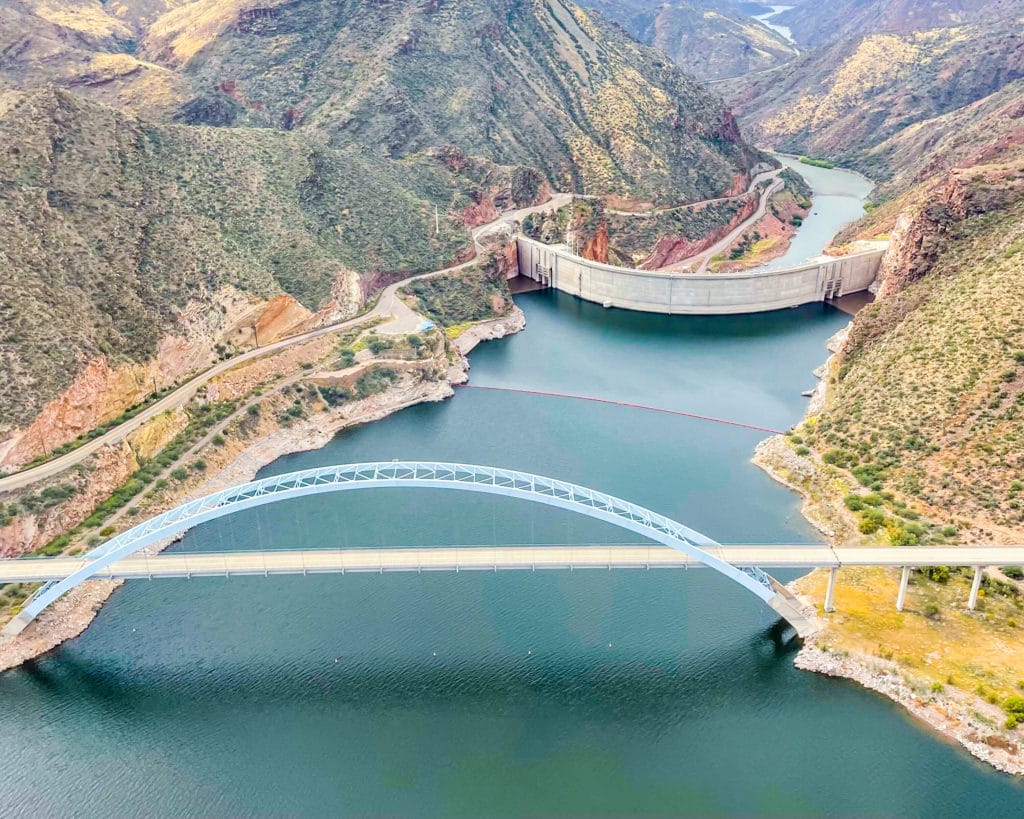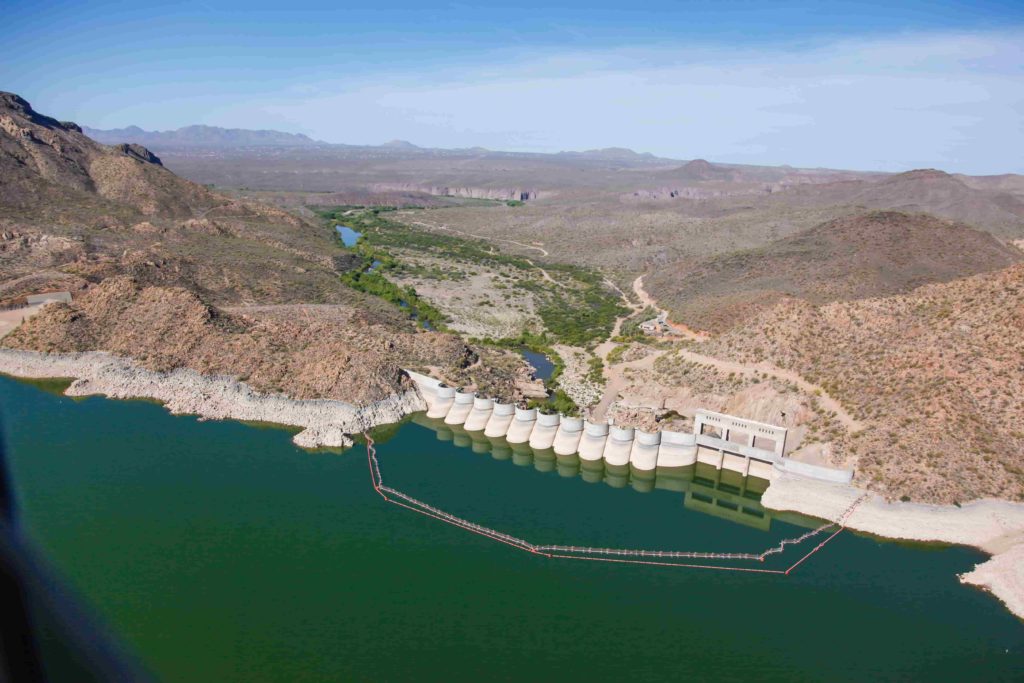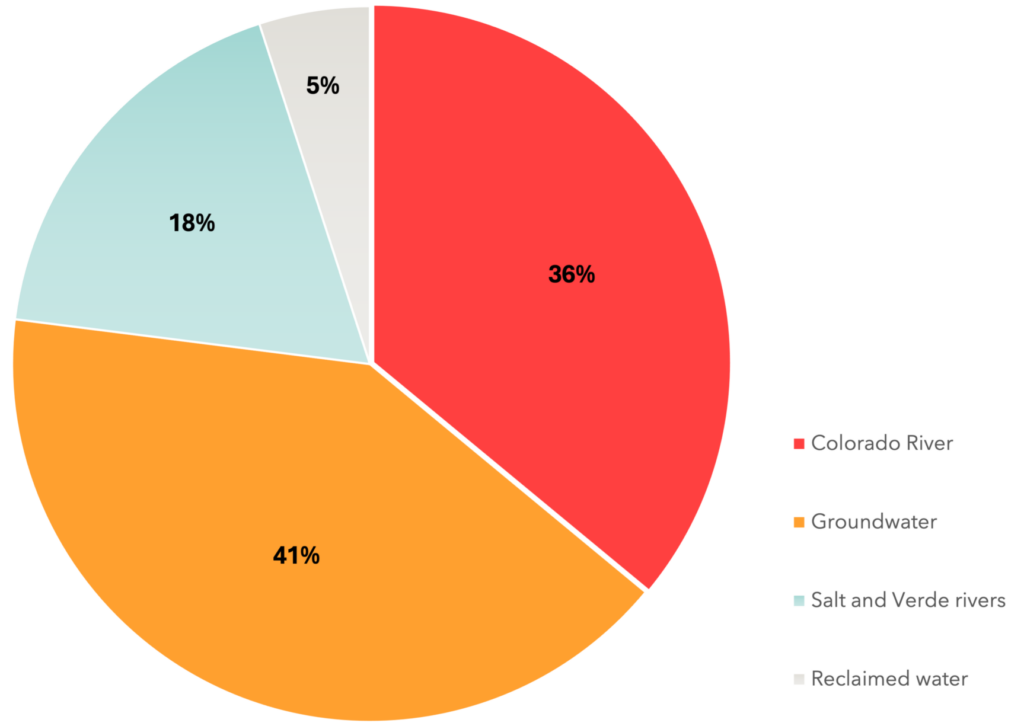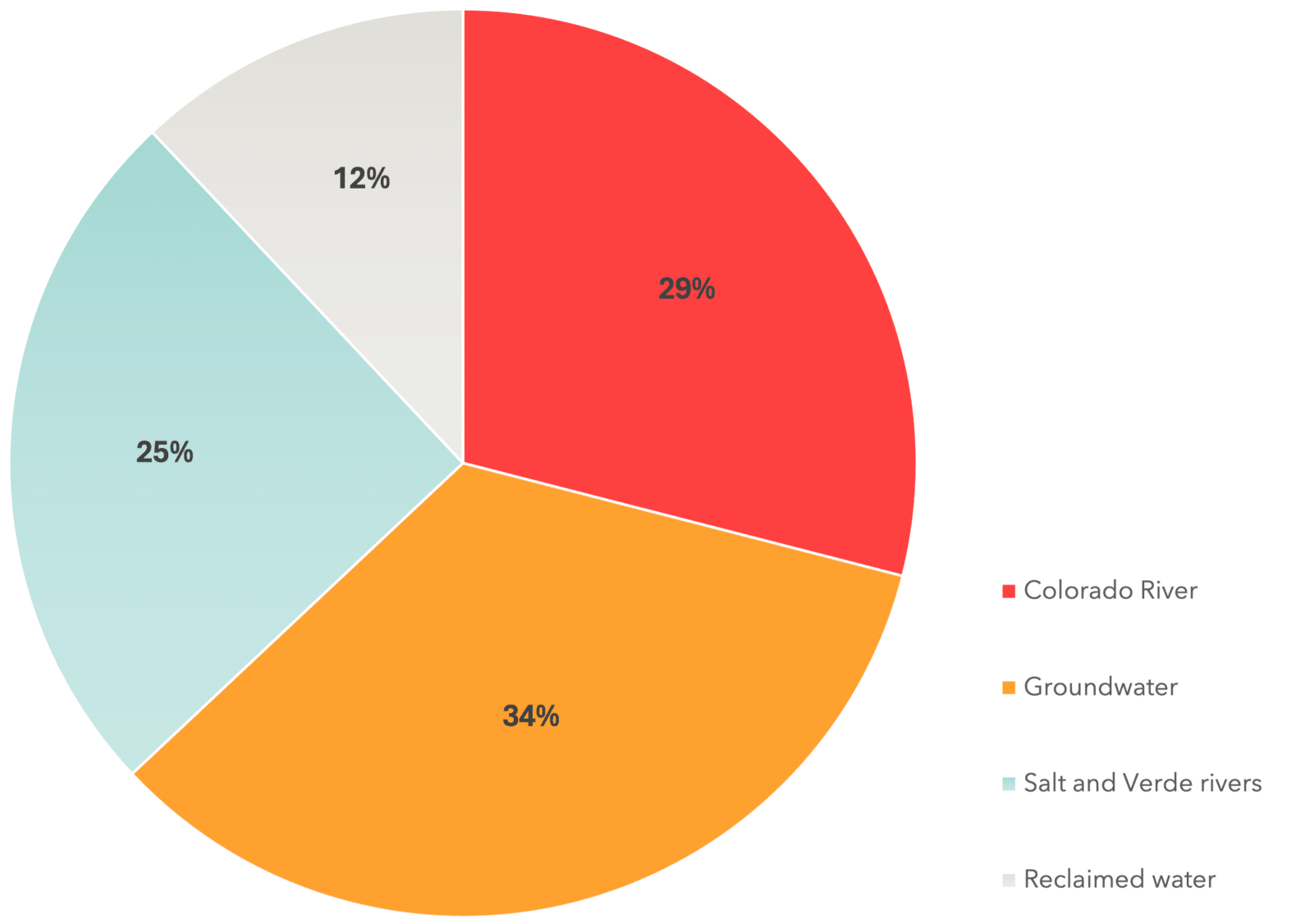
Understanding Arizona’s Water Position
Water is a precious resource in Arizona and stewardship has been a priority since before statehood. From canal and dam construction in the late 1800s and early 1900s, Colorado River treaties and compacts with neighboring states and Mexico preempting the Colorado River Basin Project Act in 1968 to the 1980 Groundwater Management Act, Arizona’s growth in the 20th century was centered around intentional, proactive water management.
Arizona uses roughly the same amount of water today as it did in the 1950s despite a 7x increase in population and 15x economic increase thanks to increased conservation methods and reduced agriculture demand. Regional leaders recognize the challenges of planning for a resilient water future, and with innovation and more than $5 billion in funding available at the state and federal levels, Arizona is actively advancing its efforts for conservation, distribution and augmentation to address future water needs.
By the Numbers
89%
of water that is flushed or goes down the drain is reclaimed
12M
acre-feet of water is stored in AZ reservoirs & underground
100
AZ communities within an AMA must assure a 100-year water supply before platting new development
Where does water in Arizona come from?
Greater Phoenix and Arizona have four main water sources: groundwater, Colorado River water, Salt and Verde River water, and reclaimed water.
Most groundwater used in the state is fossil groundwater. In-state surface water, reclaimed water and Colorado River water are all renewable, with rivers such as the Salt and Verde replenished by annual precipitation. Because of these regulated and largely renewable water sources, Arizona is less reliant on the Colorado River than neighboring states in the basin that share its water.
Arizona Water Sources
Greater Phoenix Water Sources
Colorado River
For decades, Colorado River water and reclaimed water have been used to recharge and replenish aquifers in Greater Phoenix. The federal government, states and tribes that share the river, and Mexico have worked to shore up water levels in Lake Mead and they continue to work for a resilient future on the Colorado River.
The Colorado River Basin was upgraded to a Tier 1 shortage for 2024, cutting about 8% of Arizona’s total water use. The state relies less on the Colorado River than neighboring regions do — a little more than one-third of the state’s total water use is from the river, while southern Nevada (90%), southern California (60%) and Colorado (40%) rely more heavily.
To backfill the shortage in the short-term, municipalities will use groundwater and other supplies while promoting conservation programs to reduce outdoor water use and commercial cooling water use. See long-term plans here.
Surface water
The majority of Arizona’s surface water comes from Salt River and Verde River, both managed by the Salt River Project. These watersheds are less susceptible to climate change than the Colorado River is, providing a more reliable source. The annual water demand in this system has declined over the last few decades.
Reservoir levels are at 83% capacity as of February 2024, a 4% increase from one year prior.
SRP water is available to many cities in Greater Phoenix. About 25% of tap water comes from the Salt and Verde rivers, while groundwater provides 34% and the Colorado River makes up 29%.
Groundwater
Arizona was the first state to plan for a 100-year water future by passing the 1980 Groundwater Management Act, which established the legal and physical infrastructure to assure a 100-year water supply in AMAs.
Five areas with heavy reliance on mined groundwater were identified and designated as AMAs to help meter, regulate and report on groundwater use. Municipal water providers, industrial users, and agricultural water users have been subject to these requirements since the First Management Plan became effective in 1987. The Phoenix AMA has a management plan updated every 10 years to address water use by all sectors.
Groundwater levels are generally stable or improving in Greater Phoenix.

Arizona Water Management
Arizona’s total annual water demand is around 7 million acre-feet, and each municipality, community or water provider has its own portfolio of supplies to manage the demand.
The 1980 Groundwater Management Act regulates the use of groundwater, specifically through Irrigation Non-Expansion Areas (INAs) and Active Management Areas (AMAs).
- In INAs, wells larger than residential are metered. Groundwater usage is required to be reported annually.
- AMAs require metering and reporting of groundwater use, prohibit new irrigated agriculture, and require proof of 100-year water supply availability before a development of six or more homes can be platted.
Every 10 years, the Arizona Department of Water Resources (ADWR) develops a new management plan for each AMA with the aim of achieving “safe yield” — the long-term equilibrium of groundwater withdrawn and replenished.
There are seven groundwater basins within the Greater Phoenix AMA. Over the last 10 years, groundwater levels have increased in the Carefree Basin and the East Salt River Sub-basin but decreased in the Rainbow Valley sub-basin. The other four sub-basins have been stable. Local aquifers are largely protected through the 1980 Groundwater Management Act and the resulting Assured Water Supply Program. More than 89% of water entering the Greater Phoenix waste stream is reclaimed and reused for parks, schools, golf courses, and other uses, and only a fraction of agricultural flood irrigation amount results in incidental aquifer recharge.
Recent Developments
June 2023 Phoenix Active Management Area (AMA) update
In 2023, Governor Hobbs and the ADWR unveiled the Phoenix AMA Groundwater Model and ADWR’s latest study of groundwater conditions across the Phoenix metropolitan area. According to the AMA Model, there will be shortfall of approximately 4% of unmet groundwater demands over the next 100-year period. Actions taken as a result of the Model findings protect groundwater for future generations and in no way signal an immediate crisis.
- In compliance with Assured Water Supply rules, Arizona temporarily halted approval of new Certificates of Assured Water Supply reliant on groundwater
- All existing housing certificates can proceed as planned
- There is a substantial number of housing certificates that have already been approved
- Greater Phoenix currently has 1,890,294 residential units, including both multifamily and single-family residences, either under construction, proposed, or approved
- Cities with a Designation of an Assured Water Supply can continue to develop their housing stock as planned
- In certain areas, growth will need to rely on existing and planned water sources other than groundwater
The 1980 Groundwater Management Act and the resulting Assured Water Supply rules work as intended to protect regional groundwater stocks, move development to the use of renewable water supplies, and ensure reliable, resilient water supplies for current and future generations.
AMA Report Impact
The temporary halt does not indicate a water crisis in Arizona but rather demonstrates the effectiveness of existing regulations to ensure regional water security.
- Existing homeowners will not face impacts and will continue to receive water deliveries
- Existing Certificates and developments utilizing non-groundwater sources are not affected.
- The Model results do no impact new development in the boundaries of cities with a Designation of and Assured Water Supply, including nearly all of the large cities in Greater Phoenix.
- Urban growth in other areas will need to rely on water supplies other than non-replenishable groundwater, aligning with the 1980 Groundwater Management Act.
- Development on non-subdivided land is not subject to the Assured Water Supply Program and will not be affected by the Model results.

Looking to the future
Arizona continues to bolster investments in a multi-faceted portfolio of water supplies. In 2022, the Arizona Legislature placed significant responsibilities for funds allocation with the Water Infrastructure Finance Authority (WIFA), making the authority a key driver in future planning for the long-term water supply. Its budget allocation includes:
- Water Supply Development Revolving Fund for projects needs of small, rural communities outside of Arizona’s major urban centers. WIFA can provide up to $2 million in grant funding and up to $3 million in a low-interest loan for a total of $5 million in assistance per application.
- $200 million for financing improvements in municipal water infrastructure
- Water Conservation Grant Fund – 189 Applications with approximately $200 million in funding already awarded
- Long-Term Water Augmentation Fund – $1 billion investment for projects that import new water supplies, of which $523 million have been awarded as of the end of FY24
The state’s intentional water planning makes the subject less daunting than other environmental challenges faced across the U.S:
- Compared to building expensive infrastructure to minimize the harm caused by floodwater or rising sea levels, moving a defined quantity of water to bolster Arizona’s supply is more attainable and affordable.
- Groundwater in Greater Phoenix has been protected through the 1980 Groundwater Management Act as a fallback supply for times of Colorado River shortages.
In addition to desalination as a long-term goal, future water resources could include brackish groundwater, direct potable reuse of reclaimed water, transfers of Colorado River water rights or limited inter-basin transfers of groundwater. Furthermore, the Inflation Reduction Act (IRA) includes $4 billion that will go toward water management and conservation efforts in the Colorado River Basin.
Families and businesses considering a move to Arizona can trust that water security is a serious focus for both public and private leaders in the region.


